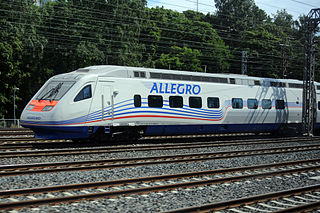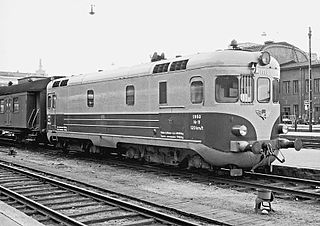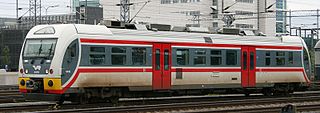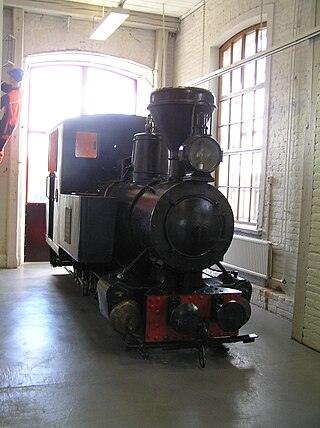Related Research Articles

VR-Group Plc, commonly known as VR, is a government-owned railway company in Finland. VR's most important function is the operation of Finland's passenger rail services with 250 long-distance and 800 commuter rail services every day. With 7,500 employees and net sales of €1,251 million in 2017, VR is one of the most significant operators in the Finnish public transport market area.

The Sr2 is a class of electric locomotives of the VR Group. They were built by SLM/ABB and later by Adtranz and finally Bombardier Transportation and assembled by Transtech Oy. They are closely based on the class Re 460 locomotives of Swiss Federal Railways.

The Sm3 Pendolino is a class of high-speed body-tilting trains operated by VR Group. It is a member of the Pendolino train family; its design is based on the ETR 460. The first two trainsets were assembled in Finland by Rautaruukki-Transtech in the mid-1990s. The rest of the series of eighteen EMUs were built by Fiat Ferroviaria between 2000 and 2006. The trains serve most of Finland's major cities such as Helsinki, Turku, Oulu and Joensuu with a maximum speed of 220 km/h (140 mph), although this speed is only attained between Kerava and Lahti. The train has a power output of 4,000 kW (5,400 hp) and weighs 328 tonnes.

Allegro was the brand name of a now defunct high-speed train service, operated by Alstom VR Class Sm6 trains, between Helsinki, Finland, and St. Petersburg, Russia.

The VR Class Hr11 was the first class of line-haul diesel locomotives used by Valtionrautatiet. Only five units were built, all delivered by Valmet in 1955. The Maybach diesel engines used in the locomotives proved highly unreliable, resulting in a complete overhaul of the engine-transmission system in 1956–58, but this did not solve all of the reliability problems. The Hr11 series was withdrawn from service in 1972.

The Sibelius was a train run daily by VR between Helsinki, Finland, and St. Petersburg, Russia. The service began on 31 May 1992 in order to ease congestion on the night service train Repin and due to the fall of the Soviet Union, where traffic was increased on the border.

The Dm12 is a diesel railcar operated by VR Group.

The Dm10 was an experimental diesel multiple unit built by VR Group's Pieksämäki workshop in 1994. It was based on a blue passenger carriage, Eit 23018, which was fitted with two diesel engines taken from HKL buses 601 and 608. The train had 80 no-smoking seats and had the driver selling tickets, which was unusual for Finnish conditions. During testing, it was run under the nomenclature KOEMV 9991, transporting Finnish President Martti Ahtisaari in Savonia in May 1994.

Before 1942, the VR Class Vr1 were originally classified as L1. The Vr1 was a powerful and effective locomotive. Part of them were built by Tampella and part by Hannoversche Maschinenbau AG of Germany. They were numbered 530–544, 656–670, 787–799 and were nicknamed “Kana” ("Hen"). They were operation from 1913-1974.

The VR Class Tr1 is a class of heavy freight locomotive built in Finland and Germany. Before 1942 VR Class Tr1s originally had the class name R1. They were nicknamed “Risto”, after the Finnish President Risto Ryti. They were numbered 1030–1096.

VR Class Tve2 was a VR Group diesel shunting locomotive. They were ordered from the Saalasti Oy engineering company and built between 1962 and 1964. Locomotives was sent to the Turenki sugar factory. A total of 8 units. The manufacturer's designation for the model was OTSO2 and OTSO2/VR.

VR Class Rro was a locomotive of Finnish origin. The Rro portion of the name comes from a word RautatieRakennusOsasto which is the Railway Construction Department.

The Hikiä railway station is located in Hausjärvi, Finland, in the village and urban area of Hikiä. It is located along the Riihimäki–Lahti line, and its neighboring stations are Riihimäki in the west and Oitti in the east.

The Mommila railway station is located in Hausjärvi, Finland, in the village of Mommila. It is located along the Riihimäki–Lahti line, and its neighboring stations are Oitti in the west and Lappila in the east.

The Lappila railway station is located in Kärkölä, Finland, in the village and urban area of Lappila. It is located along the Riihimäki–Lahti line, and its neighboring stations are Mommila in the west and Järvelä in the east.

The Savonlinna railway station is located in the town of Savonlinna, Finland. It is located along the Huutokoski–Parikkala railway, and its only neighboring station is Pääskylahti in the west.

The Nikkilä railway station is located in the village and urban area of Nikkilä, in the municipality of Sipoo, Finland.

The Lyly railway station is a closed station located in the municipality of Juupajoki, Finland, in the village of Lyly. It was located along the Tampere–Haapamäki railway, and its nearest open stations are Korkeakoski and Juupajoki in the south and Vilppula in the north.

The Vaajakoski railway station is a station located in the district of Vaajakoski in the city of Jyväskylä, Finland. It is located along the Jyväskylä–Pieksämäki railway, and has since 1992 only served freight traffic, as well as a passing loop; the nearest station with passenger services is Jyväskylä in the west.
References
- 1 2 3 4 "VR purki miljoonien kiskobussikaupan". Mtv3.fi (in Finnish). 10 November 1997. Retrieved 27 July 2011.
- ↑ Cajander, Riku (28 September 1997). "Espanjalaisten kiskobussien käyttöönotto kangertelee". Ympäristöuutiset (in Finnish). YLE . Retrieved 27 July 2011.
- ↑ "VR tuo kiskobussin Keski-Suomeen". Mtv3.fi (in Finnish). 14 February 1997. Retrieved 27 July 2011.
- ↑ Rauhala, Jorma (27 January 1999). "Dv15 1985 ja Dm11:t" (in Finnish). Vaunut.org. Retrieved 2 October 2011.
- ↑ Roosma, Andrus (9 June 2000). "Railbus from Spain" . Retrieved 27 July 2011.
- 1 2 Kutvonen, Juha (31 December 1997). "Lätän jälkeistä elämää 3..." (in Finnish). Vaunut.org. Retrieved 27 July 2011.
- 1 2 Rauhala, Jorma (20 March 1997). "Dm11 4401" (in Finnish). Vaunut.org. Retrieved 27 July 2011.
- ↑ Rauhala, Jorma (10 September 1997). "Dm11 4401" (in Finnish). Vaunut.org. Retrieved 27 July 2011.
- ↑ "VR:n kiskobusseista uusi tarjouskilpailu". STT (in Finnish). MTV3. 11 December 1997. Retrieved 28 July 2011.
- ↑ "VR:n kiskobussikauppa epäonnistui taas". Resiina (in Finnish). Museorautatieyhdistys ry, Suomen Rautatiehistoriallinen Seura ry. 22 December 1998. Retrieved 28 July 2011.
- ↑ "VR järjestää taas tarjouskilpailun kiskobusseista". Resiina (in Finnish). Museorautatieyhdistys ry, Suomen Rautatiehistoriallinen Seura ry. 16 November 1999. Retrieved 28 July 2011.
- ↑ "VR tilaa kiskobussit Tsekistä". Resiina (in Finnish). Museorautatieyhdistys ry, Suomen Rautatiehistoriallinen Seura ry. 30 August 2001. Retrieved 28 July 2011.